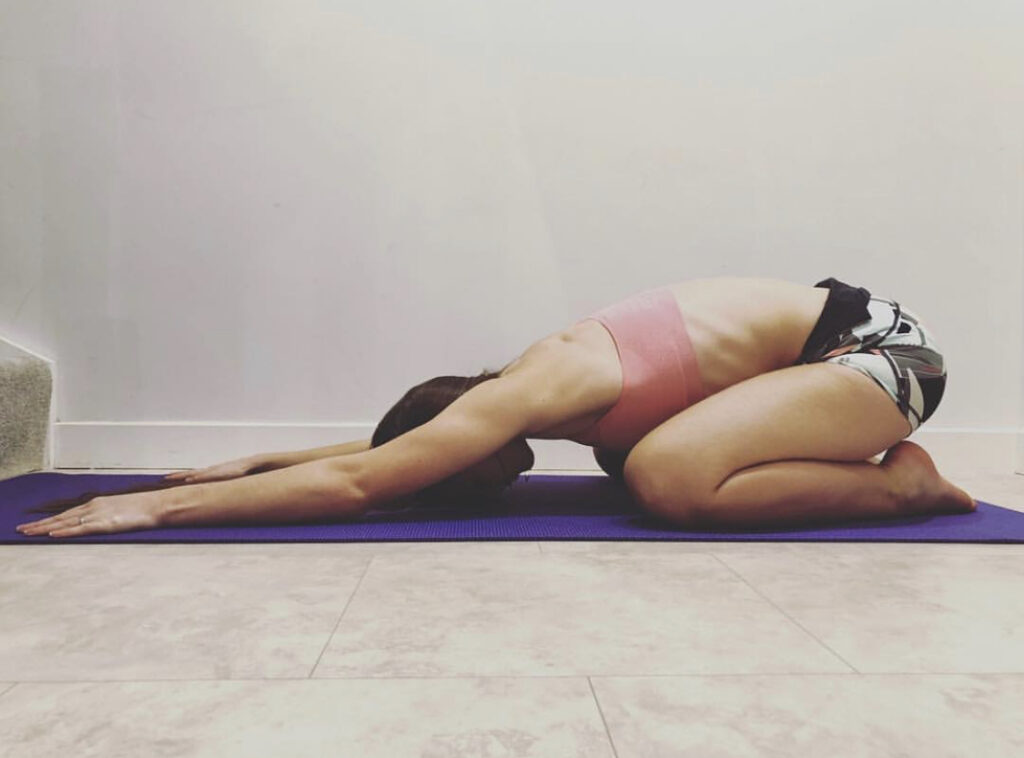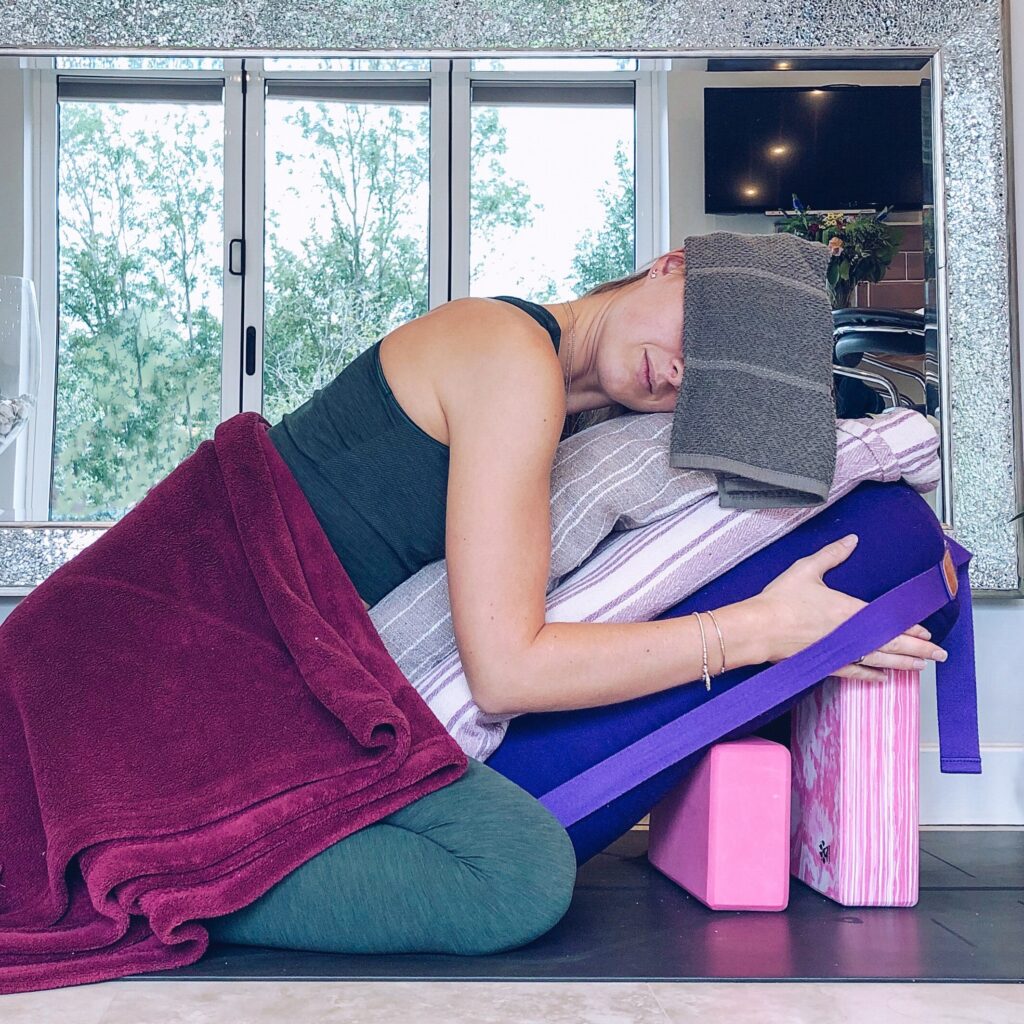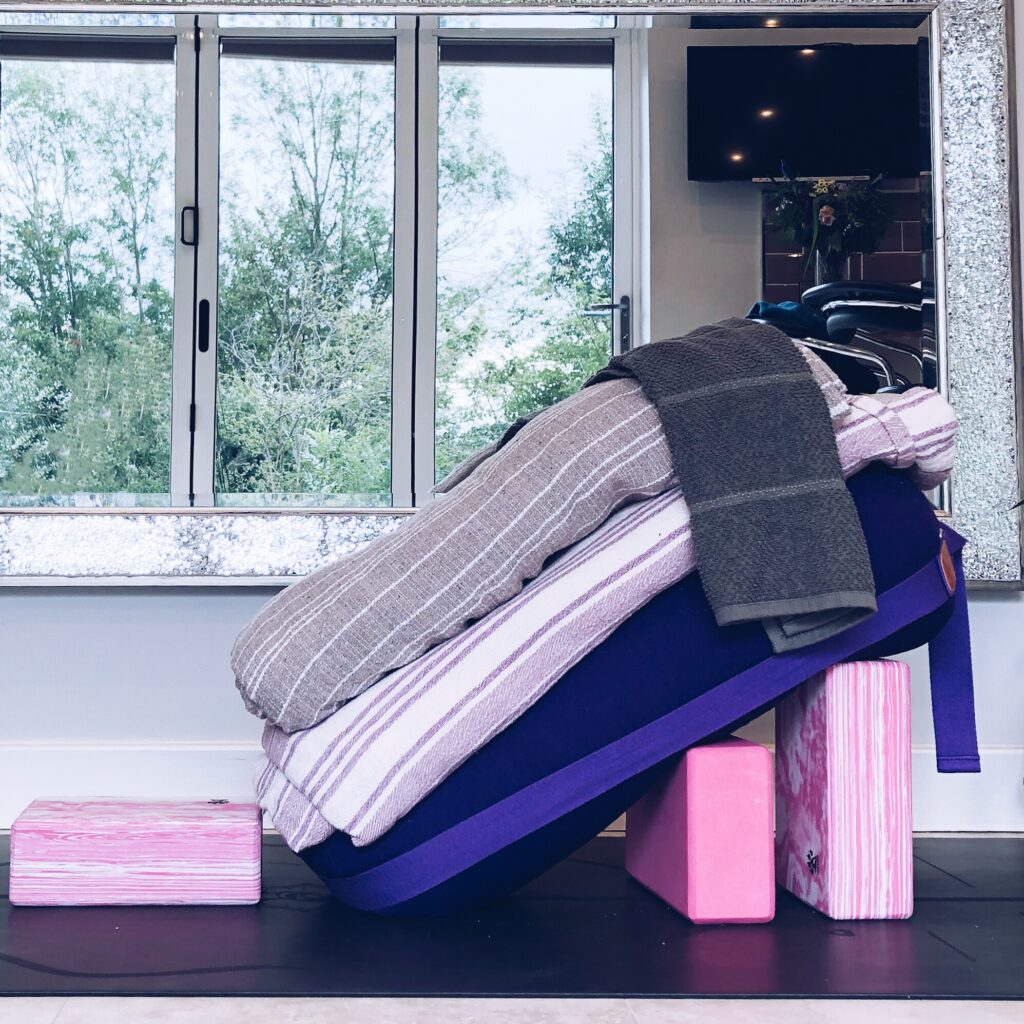
Child’s pose is a restful pose that can be returned to again and again during practice. It is known as the ‘universal counterpose’, often being sequenced between more challenging asanas, particularly those involving gentle spinal extension or inversions such as sirsasana (headstand).
Salamba Balasana Etymology
Salamba meaning “to support”
Balāsana
Bala meaning “child”
Āsana meaning “posture” or “seat”.
Also known as Shashankasana, hare pose or moon pose.
The Sanskrit word Shashank means moon and is derived from the word, Shash meaning hare and ank meaning lap. In Indian folklore the moon has been said to resemble the shape of a rabbit or hare with the moon in its lap. The moon of course is also a calming and cooling influence which is a major benefit of the asana.
The asana itself also resembles the shape of a baby (hence child’s pose) or hare. By imitating animal postures, it has been suggested that we may learn to live as they do, better in harmony with the environment and our own bodies.
Balasana versus Restorative (Salamba) Balasana
You will likely be familiar with the basic form of Balasana practiced without the use of props. There are several variations which involve forward folding in the kneeling position to bring the torso to rest on or between the thighs. This can be a surprisingly difficult pose to access and to tolerate for many practitioners unaccustomed to spending time in the kneeling position and particularly for those with knee and ankle pain or injury. The restorative variation shown below vastly increases the accessibility of this pose and as with all restorative set-ups maximises the opportunity for rest and relaxation. Further modifications are also possible, see key practice notes.

Salamba Balasana Benefits
- Evenly stretches the posterior spinal muscles.
- Creates space between the vertebrae, particularly in the lower back, reducing tension and pain.
- Can be beneficial for reducing menstrual cramps.
- Calms the mind and relaxes the body, quietening the brain.
- Quietens and cools the mind.
Salamba Balasana Cautions and Contraindications
- Knee injury
- Ankle injury
How to practice
Props
- Mat
- Round bolster
- 2-4 blankets
- Yoga strap
- 3-4 yoga blocks
- Eye mask or hand towel
Entering the pose
1. Gather your props and set up your mat. You may prefer to practice on a carpeted area or rug to provide extra comfort and support for your knees and lower legs.
2. Loop your strap lengthways around the bolster. Secure it so that it is tight enough to just allow your palms to wriggle under it.
3. Set up your props as shown below:

- Arrange two blocks, one with its long axis to the mat and one on its short axis to the mat.
- Arrange your bolster on top of these blocks so that it is at 45 degrees. If you are not using a firm bolster, you may require extra blocks or bricks to support the bolster in this position.
- Place another block at the low end of the bolster. This will be placed lengthways between your legs.
- Place at least one blanket, folded lengthways over the bolster.
4. Sit on your block in a kneeling position with your folded legs either side of the bolster
5. Fold forwards over the bolster, ensuring the abdomen is well supported and the spine rests in a gentle, soft curve. Another blanket can be added lengthways over the bolster or rolled under the sternum to achieve this. Another can also be added for head support if required.
6. Lay a blanket over the lower back and ribs.
7. Turn the head to the side and cover the eyes with an eye mask or hand towel. Alternatively, the palms can be brought up to rest on the bolster with the forehead supported on the backs of your hands.
8. If you are practicing with the head to one side, tuck the hands into the strap either side of the bolster, allowing the elbows to fall comfortably downwards with gravity. The strap should do all the work to keep your hands in place, there should be no tension in the neck and shoulders.
9. Enjoy for 3-10 minutes.
Coming out of Salamba Balasana
- Inhale deeply, on the exhale, turn your head so that your forehead is resting downwards.
- When you are ready, release your arms from the belt and using another exhale, allow them to assist you to sit up. Avoid arching your back on exit from the pose.
- If you wish, you can tuck the toes and again using your hands for assistance push into the floor to transition into Uttanasana (standing forward bend)
- You can spend a few breaths here, swaying gently from side to side before transitioning quietly into your next pose.
Duration
- Gradually increase the amount of time spent in this pose until it can be held comfortably for at least 3 minutes
- If practicing with the head to one side, be sure to spend at least 2 to 5 minutes on either side.
Awareness
- Forward bends provide a space for reflection. Rest your attention as well as your body and become aware of the natural rhythm of the breath. This pose presents a wonderful opportunity to focus the breath in the back of the lungs. It can be helpful to focus the attention on the gentle pressure of the abdomen against the bolster.
- The spiritual awareness should be on Manipura (Naval) or Svadhisthana (Sacral) Chakra
Key Salamba Balasana practice notes
- The back should be curved evenly from the pelvis to the base of the skull with the neck supported in gentle flexion. Do not be afraid to modify your props in order to achieve this.
- The purpose of Balasana is to open the back body and to close the front body.
- For those with knee pain or injury or practitioners unaccustomed to sitting on the floor this pose can be modified to be practiced seated in a chair. The set-up is essentially the same although the props are set up across two chairs facing one another rather than on the floor. It can also be modified over a desk or table.
If you’re looking for a more gentle practice, or you think your mobility may hold you back then consider the benefits of chair yoga
To learn more about restorative yoga check out our free restorative yoga ebook here.
Learn more about the different ways I can support you with your yoga: Studio Yoga classes, Online Yoga Classes & Corporate Yoga Classes.